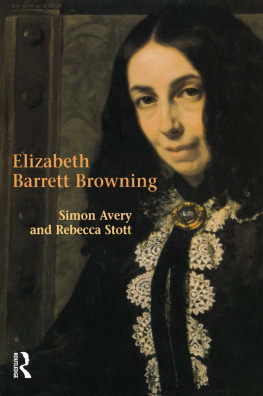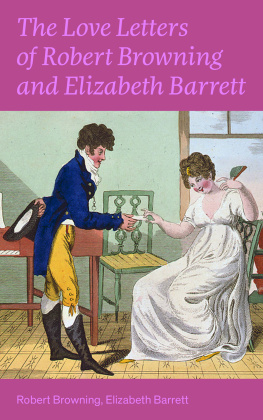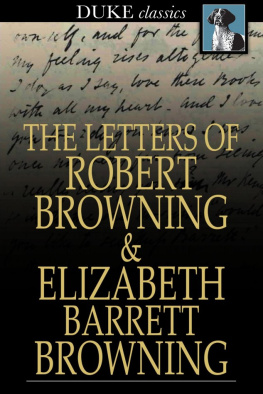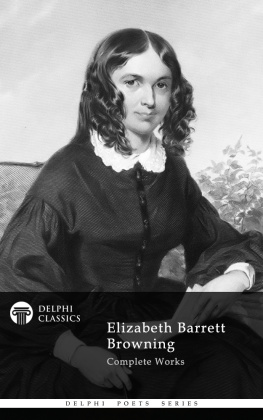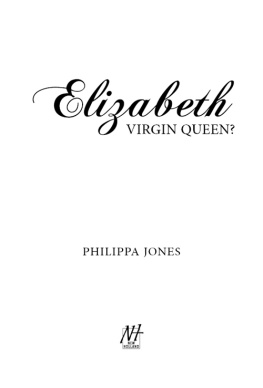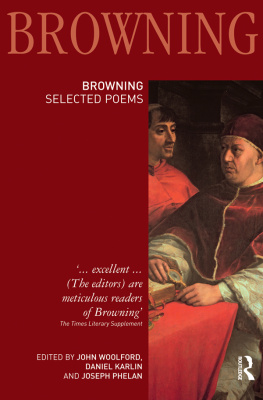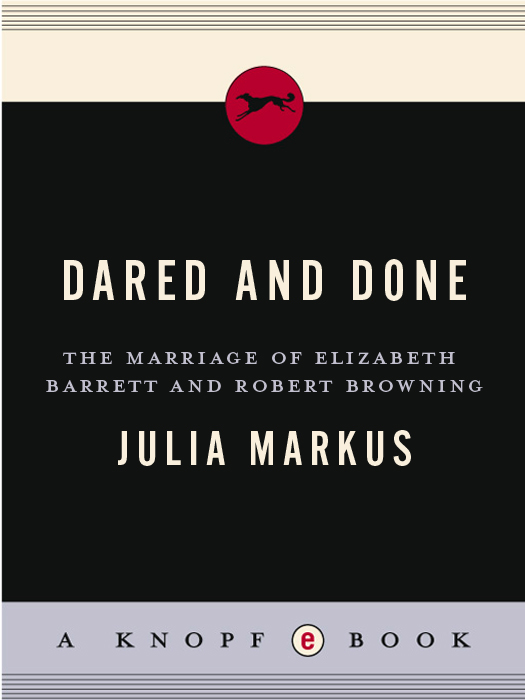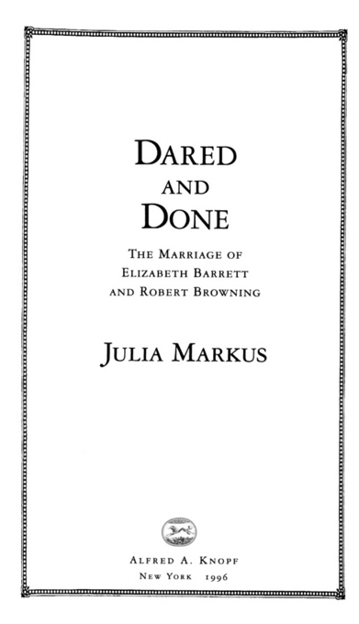This Is a Borzoi Book Published by Alfred A. Knopf, Inc.
Copyright 1995 by Julia Markus
All rights reserved under International and Pan-American Copyright Conventions. Published in the United States by Alfred A. Knopf, Inc., New York, and simultaneously in Canada by Random House of Canada Limited, Toronto. Distributed by Random House, Inc., New York.
My thanks to Hofstra University for its constant support of my work and for a special leave, and to the National Endowment for the Humanities, which helped me to complete this book with a summer research and travel grant and a Fellowship for College Teachers and Independent Scholars.
Library of Congress Cataloging-in-Publication Data
Markus, Julia.
Dared and done: the marriage of Elizabeth Barrett and Robert Browning / by Julia Markus. 1st ed.
p. cm.
Includes bibliographical references.
eISBN: 978-0-307-83297-9
1. Browning, Robert, 18121889Marriage. 2. Browning, Elizabeth Barrett, 18061861Marriage. 3. Poets, English19th centuryBiography. 4. Authors spousesGreat BritainBiography. I. Title.
PR4232.M27 1995
821.809dc20
[B] 94-11573
v3.1
A LSO BY J ULIA M ARKUS
NOVELS
Uncle
American Rose
Friends Along the Way
A Change of Luck
EDITION OF
Elizabeth Barrett Brownings
Casa Guidi Windows
F OR MY MOTHER , R UTH S ELMAN M ARKUS
C ONTENTS
A N OTE ON T RANSCRIPTIONS
E LIZABETH B ARRETT B ROWNING used a particular form of punctuation in her letters, two dots [..], at times to indicate a pause, a comma, or a dash. I have turned this signature into a comma or a dash very rarely, only when necessary for clarity in the text. With very few exceptions, noted when possible, I retain the poets usage.
In EBBs time the Moulton was often dropped from her last name; she called herself Elizabeth Barrett Barrett. I do not hyphenate the family name Moulton Barrett when I am referring to her, her father, or her siblings. That came later. In some of the printed texts of the Brownings letters, there are occasional misspellings as well as occasional spellings and usages that we now consider American. In my transcribing from printed sources, as well as in my transcribing of manuscript material, I have been as faithful as I can to the text as it appears. Because of the signature two dots and the necessity of ellipses in the middle of quoted passages I have avoided ellipses at the beginning and ending of quotations as much as possible. Accuracy and readability have been my goals. All quotations from the Brownings poetry are taken from the volumes of their work listed in the bibliography.
I NTRODUCTION
T HE LETTER that began the most famous courtship of the nineteenth century opened, I love your verses with all my heart, and I love you too.
One might say, at that very moment, as he wrote the words, he fell in love.
I thank you, dear Mr. Browning, from the bottom of my heart, Elizabeth Barrett answered on the very next day, January 11, 1845, beginning a correspondence that would last for twenty months. The two would write each other 573 letters during that time574 if we include the one Elizabeth asked him to burn. The last word was Elizabeths, written on a Friday night, September 18, 1846, on the eve of their journey to Italy.
The letters confirm that the one myth about the Brownings that was absolutely true was the most romantic onethe drama of their courtship. Robert Browning fell in love with an invalid poet, wrote to her, visited. Their love took her from the couch she hardly ever left, down the stairs of the house on Wimpole Street, to the drawing room, to a walk in the park, and then to Italya climate that would support their art and her health.
It was a remarkable correspondence and has been the basis of many an interpretation, among them an enormously successful stage playThe Barretts of Wimpole Street. Perhaps today, when the drama of family secrets is in and on the air, this play about what was going on in the Barrett household in London in the 1840s among a widowed father and his grown children seems dated, stereotypical, tame. But for an earlier generation, slowly coming to grips with Sigmund Freud and, through Eugene ONeill, beginning to look at the family in a new way, Rudolph Besiers 1930 work must have been a tantalizing way, a thrilling way, a less complicated way, of confronting some of the darker realities of respectable domestic life.
The Barretts of Wimpole Street dealt with the tyrannical aspect of Elizabeths father, Edward Barrett Moulton Barrett, who wanted to keep his children, particularly his favorite daughter, Elizabeth, for himself and away from suitors. On the stage, when not stern, Moulton Barrett was overaffectionate toward Elizabeththe whiff of incest, like one stick of incense burning through the darkened theater.
Goodness knows what this play stirred up night after night, year after year, in its devoted audience. I often wonder what my own grandmother felt, with her early experience of a sick mother and a difficult stepfather, as she, like so many of her generation, picked up the pattern and knitted her own Barretts-of-Wimpole-Street blanket, modeled after the one the invalid Elizabeth threw over her lap on stage. What a beautiful cover it made.
The play was inspired by a fact of Elizabeth Barretts life evident in the love letters, a fact again so crazily mythic in its post-Freudian significance that it is difficult to look directly at the implications of its truth. Her father, a wealthy, landed gentleman, a responsible if stern father, and a widower, had twelve children, eleven of whom reached adulthood, nine of whom survived. He simply had one stipulation, as ironclad as it was unspoken: None of them, male or female, was allowed to marry. The three who did disobey in his lifetime were disinherited, not only from the material things he controlled but from any further contact with their father. To him, they were dead.
Earlier audiences did not have to go far to see psychic roots for the physical maladies, the excruciating condition of the lungs, that wracked Elizabeth Barretts existence. Nor did they have to linger on the specific pain and guilt that precipitated her isolation on Wimpole Street to empathize with her escape from it. The father was cast as the villain and the daughter in her late thirties as the waif rescued by romantic love. Yet in the love letters the daughter does not blame her father for the steps she must take to live her own life. Her cross was heavier to bear. She took full responsibility for her actions, her free will, and the pain she would cause her father. The passion and love between Elizabeth and Robert was not a case of mutual self-absorption, and though it was first love for both, it was not the first love of children.
Who Moulton Barrett really was is more complicated. He was born in Jamaica, the heir of a great fortune as the legitimate grandson of Edward Barrett of Cinnamon Hill. His grandfather was one of the richest landholders, rum and sugar exporters, and slaveholders in the West Indies. The Barrett family had been in Jamaica since it was colonized in the seventeenth century. His daughter Elizabeth was the first Barrett to be born in England in many generations. No wonder when his first son was born less than sixteen months later, drums sounded at Cinnamon Hill and the slaves were given a half-day holiday. Though Moulton Barrett, a deeply religious man, must have had religious scruples against slavery, he was a staunch supporter of the system that supplied his living until its end. His form of devout Christianity led him to a belief that a mans household, wife and children included, were his chattel, and that all were morally obliged to obey his every word. His interpretation of the Bible was underscored by his early years in Jamaica and by his later business concerns. He was born to be the benevolent master.



